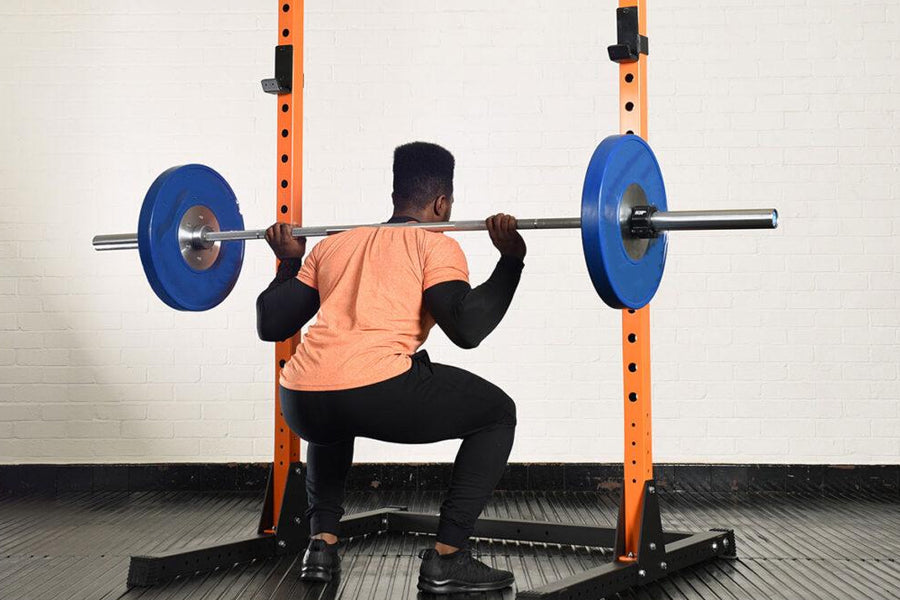Step right up, folks, and behold the most beloved piece of gym equipment - the squat rack. It's where the magic happens, where dreams of buns of steel and superhero-like strength are forged.
But don't be intimidated by the rack's impressive reputation. Watching experienced lifters hoist weights that could crush a small car can be daunting, but don't let that dissuade you.
With the proper technique and determination, you can join the ranks of squatting superstars. So, don't be scared of the big, bad squat rack! Even if you're a newbie to weightlifting, we'll break down everything you need about this powerful equipment.
By the end of this guide, you can have the knowledge and confidence to conquer your squat rack fears and focus on sculpting those muscles. So, let's dive in and prepare to rack up some gains!
What Exercises Can You Do With a Squat Rack?

Be aware of the name - power racks, half racks, and squat stands are the ultimate multi-taskers of the gym world! Sure, they're perfect for squats (obviously), but their versatility extends far beyond that.
With customized height settings and strategic hooks and pins, you can use squat racks to execute any kind of squat, front or back. Plus, even without those bells and whistles, these racks can still accommodate a range of other exercises.
So, if you are looking for a way to achieve a Herculean upper body without leaving the comfort of your own home, the pull-up bar is another constituent of the squat rack! This critical component of any personal squat rack can enable you to tackle various hanging exercises, including chin-ups and hanging leg raises.
So why settle for a mere mortal workout when you can unleash your inner superhero with the help of a trusty pull-up bar? There is good news for those tired of fumbling around trying to hoist a barbell onto their shoulders for specific exercises. Squat racks are one of all kinds of solutions.
These sturdy supports are the perfect place to prop up your barbell, making moves like bent-over rows and barbell shrugs a breeze. So, why save your energy for the workout and let the squat rack do the heavy lifting for you?
This versatile squat rack is used for more than just squats. You will be amazed that with this bad boy, you can pump out military presses, incline bench presses, decline bench presses, flat bench presses, and any other variation of bench press you fancy. Get ready to feel the burn and get creative with your exercises.
Sure, you might associate the squat rack with, well, squats. But did you know you can do much more with this versatile equipment? We are talking lat pulldowns, pull-ups, dips, and more. The endless possibilities make this bad boy a total game-changer in your workout routine.
And remember, the next time someone complains about "that" lifter at the gym using the squat rack for bicep curls. You'll know a whole world of possibilities is waiting for them to discover.
How to Use Squat Rack for Hip Thrust
You can give your glutes the workout of their lives using a squat rack for hip thrusts. First, you must adjust the safety pins to just the right height for your seated position.
Then, with a barbell across your hips and your feet planted firmly, it's time to get thrusting! Remember to brace your core and squeeze your glutes at the top of each movement. With these tips in mind, you can be on your way to a killer lower-body workout.
Related Article: Hip Circle Bands: The Coolest Way to Get Glutes You Have Always Dreamed of
How to Use Squat Rack for Bench Press
If you want to pump up those pecs, follow these simple steps to bench press like a pro. First, set those safety pins to the perfect height for your lift. No need for any unnecessary accidents. Then, adjust the neoprene dumbbell to your desired position because you have to be comfortable.
Now lie down on the adjustable bench and grip the barbell, feeling that adrenaline rush. Slowly lower the weight towards your chest, keeping your elbows tucked in. And then BAM! Push that weight up towards the sky, feeling like a superhero. Repeat for your desired number of reps, but keep it within a reasonable distance.
Safety first, friends. Finally, carefully set the barbell back on the squat rack and bask in the glory of your killer workout.
How to Use Squat Rack for Deadlift
Get ready to step up your workout game and unlock the secrets of deadlifting using a squat rack! Begin by setting the barbell to just below knee height. Next, stand with feet slightly wider than shoulder-width apart while gripping the barbell overhand.
Push hips back and lower body down into starting position, all while keeping chest lifted and back straight as a rod. Unleash power from within - drive those feet against the floor, then thrust upward, extending legs & hips until fully standing upright, boasting that superhuman strength we know you're made of!
You can squeeze your glutes tight to stabilize the movement before bending your knees again, allowing the weighty load to return safely home beneath its responsible owner. You can repeat the desired number of reps, aiming higher each time.
Related Article: 10 Highly Effective Deadlift Alternatives for Beginners, at-Home Workouts, and More
How to Use Squat Rack Safely
Although there are many options out there, if you're looking for a squat rack, let's be honest, safety should be your top priority. And regarding safety, a power rack or cage is the grand champion. Don't compromise your workouts - go for the gold standard and keep those gains coming!
So, with power racks and safety pins at your disposal, you can tackle your workout with confidence and control. Plus, if you feel uncertain, you can always "ditch" the weight or bumper plates mid-set without fear of injury. It's like having a trusty workout partner who has always got your back.
Let's take a quick peek behind the iron curtain of squat racks and see how they help keep you safe while pumping iron.
J-Hooks for Holding the Barbell

Picture this you are ready to hit the gym and tackle some squats, but you struggle to get that powerlifting barbell over your shoulders. It's a struggle, and not to mention; it can be pretty risky too. But fear not because there is a solution. J-Hooks!
These little hooks may seem insignificant, but they are vital to your weightlifting routine. They come in various shapes and sizes but are always there to keep your barbell in place while you add or remove weights. Remember their importance - J-hooks are the trusty sidekick your squat rack needs!
You can step right under the barbell and get right into those squats without worrying about any unnecessary dangers by elevating the barbell off the ground. So go ahead and squat with confidence. Your shoulders and back will thank you.
And if you are tired of being stuck with a basic squat rack that doesn't cater to your height or workout preferences? Fear not, for there are squat racks out there with adjustable J-hooks! That's right; you can customize your rack to fit your needs.
Want to work on those quads? Lower those hooks to shoulder height. Want to pump up your chest? Raise them to hip level for bench presses off the rack. And for the actual workout out there, some squat racks even feature Westside Hole Spacing, giving you 2x the number of holes for endless possibilities with bar placement.
Time to level up your gym game and say goodbye to one-size-fits-all racks.
Safety Pins for Catching the Barbell

Has it ever happened to you that you are in the midst of an intense workout, finally hitting what you've been working on for weeks? As you push yourself to the limit, suddenly, you feel your grip slip, and the barbell comes crashing down. But don't panic!
Safety pins come here - these magical horizontal bars can catch the barbell and save you from potential disaster. And while they're not designed to be used as makeshift J-hooks, they still do a fantastic job at what they are created for.
That being said, there's always room for improvement, and lucky for us, there's now an even better solution on the market. Let's say goodbye to noisy disruptions and hello to a smoother workout with the latest and greatest in weight-dropping technology!
Spotting Straps for Really Catching the Barbell

Two things are specific when lifting heavy: loud clanging noises and worn-out equipment. But fear not, dear lifting enthusiast! Spotter straps are here to save the day and your belongings.
With their soft landing capabilities, the days of loud weights hitting the floor are over. They also extend the lifespan of your special lifting equipment by preventing bar-on-bar damage. Besides J-hooks, there are spotting straps!
These heavy-duty straps might not be the most glamorous gym accessory on the block, but they are a game-changer for safety and peace of mind. Spotting straps are made from industrial-grade nylon; they can hold a weight equivalent to a T-Rex and are much more versatile than their bar and pin counterparts.
It's a wonder why spotting straps aren't more popular in your local gym - it's time for a fitness revolution! However, these straps are not for the faint of heart - they're best suited for experienced lifters pushing their limits. So lift your heart out, and let those spotter straps do their thing.
How to Set Up the Squat Rack Like a Pro
Are you ready to unleash your inner gym hero? Let's dive into how to nail the working of a squat rack like a boss:
Step 1: Adjust those J-hooks to your desired height like a pro.
Step 2: Remember those safety pins/bars or spotter straps.
Step 3: Add that hefty barbell to the hooks, and feel the power surge through your veins.
Step 4: Then load up the plates, giving them an excellent collar to hold onto for dear life.
Step 5: Slide under the bar and show off your leg strength by pushing that barbell off the hooks - don't even think about using your back!
Step 6: Take a confident step back to give yourself and that weight enough space to work with.
Step 7: Now's the time to shine! Lift with all your might and channel your inner Hercules.
Step 8: You did it! Please pat yourself on the back and return that bar to its rightful place.
The Bottom Line
The squat rack is an all-in-one gym hero and is the perfect partner for various exercises, from squats and military presses to bench presses, pull-ups, and more. With handy J-hooks keeping your barbell in place and safety pins catching it in case disaster strikes, you can lift with peace of mind. Plus, those industrial-grade nylon spotter straps ensure your equipment stays in tip-top shape by consistently providing a soft landing.
Set up your squat rack by adjusting those hooks and pins to your desired height, loading up the barbell, and adding the collar for good measure. And if you need a helping hand? Look no further than the assisted squat rack, with adjustable arms to make lifting those heavy weights a breeze. Let's get swole!














